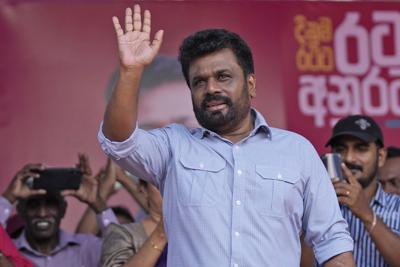When some pattern of behaviour seems inexplicable, the real reason is often history.
You could blame the Buddhist extremists of the majority Sinhalese population who led the first pogroms against the Tamil minority in 1958, or the Marxist insurrection that broke out in 1971 (30,000 dead) and resumed in 1987-89 (60,000 dead), or the government-backed attacks on Tamils that started the 26-year-long civil war in 1983 (100,000 dead).
Or you could choose the massacres of Tamils that ended that war in 2009 and brought the Rajapaksa clan to power, or the deluded Sinhalese Buddhists who went on voting for the Rajapaksas even as they looted the economy, or the 2019-2022 economic collapse that made even food and medicines unavailable to much of the population.
The austerity weighed heavily on an impoverished and disillusioned population, and in last Sunday’s election they voted a Marxist party into power. It’s the same Marxist party that launched the terrorist insurgencies of 1971 and 1987, although the current leader and new president of Sri Lanka, Anura Kumara Dissanayake, swears it will be different this time.
He’s certainly not going to start another insurrection, because he’s already in power via the ballot box. Besides, that particular form of “struggle” was an artifact of the 1960s and ‘70s and is now very much out of fashion. What worries Sri Lanka’s many creditors are the promises that got him elected.
Dissanayake’s party, Janatha Vimukthi Peremuna (People’s Liberation Front), is what you would expect from a long-established Marxist-Leninist party that has outgrown its early enthusiasm for armed revolution but still holds fast to its core “socialist” values.
That usually means low taxes, subsidies for the poor (practically everybody in Sri Lanka at the moment) and strong state intervention in the market. Dissanayake’s manifesto calls for slashing taxes and renegotiating terms for $25 billion (U.S.) of debt, and it understandably alarms the creditors.
The only way he won power this time is because a despairing and disillusioned electorate was willing to bet on any party that had not already failed. (The JVP got only three per cent of the votes in the previous election in 2019, but 46 per cent this time.) If Dissanayake cannot keep his promises, which is all too likely, the anger and the violence may return.
But why is Sri Lanka’s post-colonial history so angry and violent? None of the five major successor states to the British Empire in South Asia (India, Pakistan, Bangladesh, Nepal and Sri Lanka) has an entirely peaceful past, but none compares with Sri Lanka for sustained, large-scale violence across five decades.
It’s fashionable to blame the British Empire, because British colonial administrators preferred to hire and promote members of the Tamil-speaking Hindu minority (15 per cent of the population) rather than members of the fiercely nationalistic Sinhala-speaking Buddhist majority. This led to resentment in the majority, which led to anti-Tamil violence, etc., etc.
But this is really an inadequate explanation for the mass murders of Tamils by Sinhalese mobs, police or soldiers which are a recurrent feature of post-independence Sri Lankan history.
It’s not just Sri Lanka. Consider the brutal behaviour of Burma’s Buddhist majority toward the country’s four per cent Muslim minority, the Rohingyas. Most of the survivors now live in refugee camps in Bangladesh.
When some pattern of behaviour seems inexplicable, the real reason is often history. Buddhism rose to dominate India and most of south and Southeast Asia in 500 BC-500 AD, but was then reduced to a tiny minority of believers in the next thousand years by a revival of the old religion of Hinduism and the arrival of the new religion of Islam.
Such a huge defeat can leave lasting scars. It may have left a conviction deeper than words in the few remaining Buddhist countries that they are forever at risk of being somehow replaced by the “enemy” in their midst. Get the minority before they become the majority.
I don’t like this hypothesis, but I suspect it may be true.
